
The common buzzard is a medium-to-large bird of prey which has a large range. It is a member of the genus Buteo in the family Accipitridae. The species lives in most of Europe and extends its breeding range across much of the Palearctic as far as northwestern China, far western Siberia and northwestern Mongolia. Over much of its range, it is a year-round resident. However, buzzards from the colder parts of the Northern Hemisphere as well as those that breed in the eastern part of their range typically migrate south for the northern winter, many journeying as far as South Africa.

The eastern imperial eagle is a large bird of prey that breeds in southeastern Europe and extensively through West and Central Asia. Most populations are migratory and winter in northeastern Africa, the Middle East and South and East Asia. Like all eagles, the eastern imperial eagle is a member of the family Accipitridae. Furthermore, its feathered legs mark it as a member of the subfamily Aquilinae. It is a large, dark-colored eagle, with a resemblance to other members of the genus Aquila but it is usually the darkest species in its range. This is an opportunistic predator that mostly selects smallish mammals as prey but also a fairly large proportion of birds, reptile and other prey types, including carrion. Compared to other Aquila eagles, it has a strong preference for the interface of tall woods with plains and other open, relatively flat habitats, including the wooded mosaics of the steppe. Normally, nests are located in large, mature trees and the parents raise around one or two fledglings. The global population is small and declining due to persecution, loss of habitat and prey. It has therefore been IUCN Red Listed as Vulnerable since 1994.

The Eurasian eagle-owl is a species of eagle-owl that resides in much of Eurasia. It is also called the Uhu and it is occasionally abbreviated to just the eagle-owl in Europe. It is one of the largest species of owl, and females can grow to a total length of 75 cm (30 in), with a wingspan of 188 cm, with males being slightly smaller. This bird has distinctive ear tufts, with upper parts that are mottled with darker blackish colouring and tawny. The wings and tail are barred. The underparts are a variably hued buff, streaked with darker colouring. The facial disc is not very defined and the orange eyes are distinctive.

Buteo is a genus of medium to fairly large, wide-ranging raptors with a robust body and broad wings. In the Old World, members of this genus are called "buzzards", but "hawk" is used in the New World. As both terms are ambiguous, buteo is sometimes used instead, for example, by the Peregrine Fund.
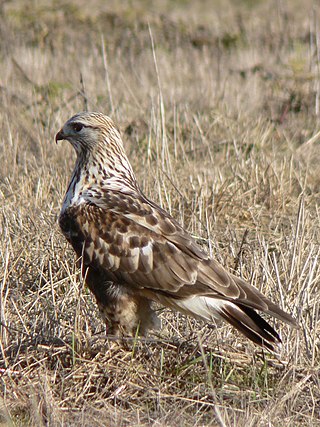
The rough-legged buzzard (Europe) or rough-legged hawk is a medium-large bird of prey. It is found in Arctic and Subarctic regions of North America, Europe, and Russia during the breeding season and migrates south for the winter. It was traditionally also known as the rough-legged falcon in such works as John James Audubon's The Birds of America.
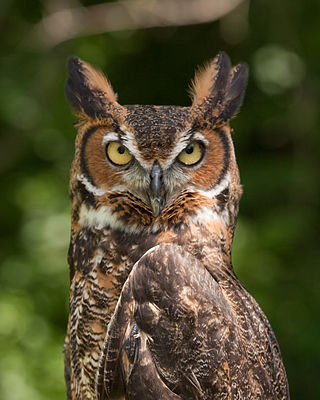
The great horned owl, also known as the tiger owl, or the hoot owl, is a large owl native to the Americas. It is an extremely adaptable bird with a vast range and is the most widely distributed true owl in the Americas. Its primary diet is rabbits and hares, rats and mice, and voles, although it freely hunts any animal it can overtake, including rodents and other small mammals, larger mid-sized mammals, birds, reptiles, amphibians, and invertebrates.

The red-tailed hawk is a bird of prey that breeds throughout most of North America, from the interior of Alaska and northern Canada to as far south as Panama and the West Indies. It is one of the most common members within the genus of Buteo in North America or worldwide. The red-tailed hawk is one of three species colloquially known in the United States as the "chickenhawk", though it rarely preys on standard-sized chickens. The bird is sometimes also referred to as the red-tail for short, when the meaning is clear in context. Red-tailed hawks can acclimate to all the biomes within their range, occurring on the edges of non-ideal habitats such as dense forests and sandy deserts. The red-tailed hawk occupies a wide range of habitats and altitudes, including deserts, grasslands, coniferous and deciduous forests, agricultural fields, and urban areas. Its latitudinal limits fall around the tree line in the subarctic and it is absent from the high Arctic. Generally it favors varied habitats with open woodland, woodland edge and open terrain. It is legally protected in Canada, Mexico, and the United States by the Migratory Bird Treaty Act.

The ferruginous hawk is a large bird of prey and belongs to the broad-winged buteo hawks. An old colloquial name is ferrugineous rough-leg, due to its similarity to the closely related rough-legged hawk.

The greater spotted eagle, also called the spotted eagle, is a large migratory bird of prey in the family Accipitridae.
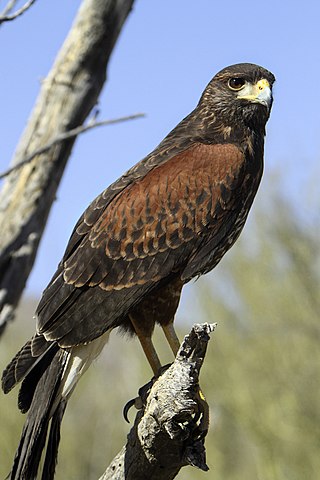
Harris's hawk, formerly known as the bay-winged hawk, dusky hawk, and sometimes a wolf hawk, and known in Latin America as peuco, is a medium-large bird of prey that breeds from the southwestern United States south to Chile, central Argentina, and Brazil. This bird is sometimes reported to be at large in Western Europe, especially Britain, but it is a popular species in falconry and these records almost invariably all refer to escapes from captivity.

The long-legged buzzard is a bird of prey found widely in several parts of Eurasia and in North Africa. This species ranges from Southeastern Europe down to East Africa to the northern part of the Indian subcontinent. The long-legged buzzard is a member of the genus Buteo, being one of the larger species therein. Despite being relatively powerful, it is considered a rather sluggish raptor overall. Like most buzzards, it prefers small mammals such as rodents, including gerbils, ground squirrels, voles and rats, also taking reptiles, birds and insects as well as carrion. Adaptable to a variety of habitats, long-legged buzzards may nest on a variety of surfaces, including rocks, cliffs and trees. it is a typical buzzard in its reproductive biology. The long-legged buzzard is widely distributed and appears to be quite stable in population. Therefore, it is considered as Least Concern by the IUCN.

Bonelli's eagle is a large bird of prey. The common name of the bird commemorates the Italian ornithologist and collector Franco Andrea Bonelli. Bonelli is credited with gathering the type specimen, most likely from an exploration of Sardinia. Some antiquated texts also refer to this species as the crestless hawk-eagle. Like all eagles, Bonelli's eagle belongs to the family Accipitridae. Its feathered legs marked it as member of the Aquilinae or booted eagle subfamily. This species breeds from Southern Europe, Africa on the montane perimeter of the Sahara Desert and across the Indian Subcontinent to Indonesia. In Eurasia, this species may be found as far west as Portugal and as far east as southeastern China and Thailand. It is usually a resident breeder. Bonelli's eagle is often found in hilly or mountainous habitats, with rocky walls or crags, from sea level to 1,500 m (4,900 ft). Habitats are often open to wooded land and can occur in arid to semi-moist climate. This eagle, though it can be considered partially opportunistic, is something of a specialist predator of certain birds and mammals, especially rabbits, galliforms and pigeons. On evidence, when staple prey populations decline or are locally scarce, Bonelli's eagle switch to being an opportunistic predator of a wide variety of birds. Despite its persistence over a large range and its continued classification as a least concern species by the IUCN, Bonelli's eagle has declined precipitously in various parts of its range, including almost all of its European distribution, and may face potential local extinction. The species' declines are due to widespread habitat destruction, electrocution from electricity pylons as well as persistent persecution.
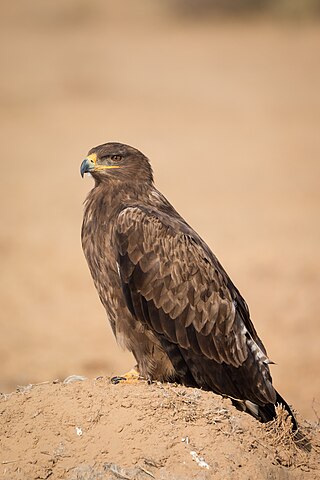
The steppe eagle is a large bird of prey. Like all eagles, it belongs to the family Accipitridae. The steppe eagle's well-feathered legs illustrate it to be a member of the subfamily Aquilinae, also known as the "booted eagles". This species was once considered to be closely related to the sedentary tawny eagle and the two forms have previously been treated as conspecific. They were split based on pronounced differences in morphology and anatomy; two molecular studies, each based on a very small number of genes, indicate that the species are distinct but disagree over how closely related they are.

The Ural owl is a large nocturnal owl. It is a member of the true owl family, Strigidae. The Ural owl is a member of the genus Strix, that is also the origin of the family's name under Linnaean taxonomy. Both its common name and scientific name refer to the Ural Mountains of Russia where the type specimen was collected. However, this species has an extremely broad distribution that extends as far west as much of Scandinavia, montane eastern Europe, and, sporadically, central Europe, thence sweeping across the Palearctic broadly through Russia to as far east as Sakhalin and throughout Japan. The Ural owl may include up to 15 subspecies, but most likely the number may be slightly fewer if accounting for clinal variations.

Ladakh is the home to endemic Himalayan wildlife, such as the bharal, yak, Himalayan brown bear, Himalayan wolf and the iconic snow leopard. Hemis National Park, Changthang Cold Desert Wildlife Sanctuary, and Karakorum Wildlife Sanctuary are protected wildlife areas of Ladakh. The Mountain Institute, Ladakh Ecological Development Group and Snow Leopard Conservancy work on "Ecotourism Opportunities in Rural Ladakh". For such an elevated, arid area, Ladakh has a great diversity of birds — 318 species have been recorded. Many of these birds reside at or seasonally breed in high-altitude wetlands, such as Tso Moriri, or near rivers and water sources.
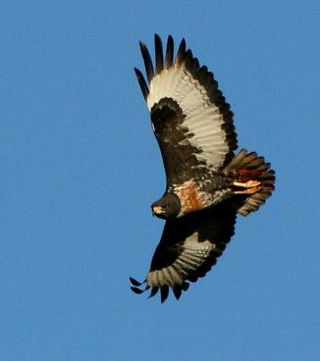
The jackal buzzard is a fairly large African bird of prey. The taxonomy of this species has caused some confusion in the past and it almost certainly belongs in a species complex with other African Buteo species. Some taxonomists have considered this species, the Archer's buzzard, and the augur buzzard to be the same superspecies. Many taxonomists consider them all to be distinct, having different calls, different home ranges and variations in plumage. This is a species that lives among mountains, and on adjacent savanna and grassland. It is resident and non-migratory throughout its range.

The augur buzzard is a fairly large African bird of prey. This species is distinct in typical adult plumage for its blackish back, whitish underside and orange-red tail, while juvenile augur buzzards are generally rather brown in colour; however a dark morph is known, which causes the bird's entire body to become darker. This member of the Buteo genus is distributed in several parts of the central and southern Africa, normally being found from Ethiopia to southern Angola and central Namibia. It is resident and non-migratory throughout its range. This is a species of mountains, and adjacent savannah and grassland. This is a typical buteonine raptor, being a generalist predator which tends to prefer small mammals supplemented by reptiles and birds among various prey items.

The Eurasian goshawk is a species of medium-large bird of prey in the family Accipitridae, a family which also includes other extant diurnal raptors, such as eagles, buzzards and harriers. As a species in the genus Accipiter, the goshawk is often considered a "true hawk". The scientific name is Latin; Accipiter is "hawk", from accipere, "to grasp", and gentilis is "noble" or "gentle" because in the Middle Ages only the nobility were permitted to fly goshawks for falconry.

The Eurasian eagle-owl may well be the most powerful extant species of owl, able to attack and kill large prey far beyond the capacities of most other living owls. However, the species is even more marked for its ability to live on more diverse prey than possibly any other comparably sized raptorial bird, which, given its considerable size, is almost fully restricted to eagles. This species can adapt to surprisingly small prey where it is the only kind available and to large prey where it is abundant. Eurasian eagle-owls feed most commonly on small mammals weighing 100 g (0.22 lb) or more, although nearly 45% of the prey species recorded have an average adult body mass of less than 100 g (3.5 oz). Usually 55-80% of the food of eagle-owls is mammalian.
























